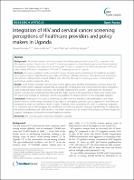| dc.contributor.author | Kumakech, Edward | |
| dc.contributor.author | Andersson, Sören | |
| dc.contributor.author | Wabinga, Henry | |
| dc.contributor.author | Berggren, Vanja | |
| dc.date.accessioned | 2020-11-11T12:20:47Z | |
| dc.date.available | 2020-11-11T12:20:47Z | |
| dc.date.issued | 2014 | |
| dc.identifier.citation | Kumakech, E., Andersson, S., Wabinga, H., & Berggren, V. (2014). Integration of HIV and cervical cancer screening perceptions of healthcare providers and policy makers in Uganda. BMC Public Health, 14(1), 810. | en_US |
| dc.identifier.uri | https://hdl.handle.net/123456789/199 | |
| dc.description.abstract | Background: HIV-positive women have an increased risk of developing cervical cancer (CC) compared to the
HIV-negative women. Despite this, HIV and CC screening programs in many developing countries have remained
disintegrated. Therefore, the objective of the study was to explore perceptions of healthcare providers (HCP) and
policy makers (PM) about integration of HIV and CC screening services in Uganda.
Methods: This was a qualitative study conducted among 16 participants comprising of 12 healthcare providers
and 4 policy makers in Uganda. Data were collected through individual interviews. Participants were purposively
selected from different level of health facilities with clinics for HIV and CC screening services. Content analysis
method was used to analyze the data.
Results: Three themes emerged from the data, namely appreciating benefits of integration, worrying about the
limited health system capacity and potential consequences of integration and feeling optimistic about integration
under improved health system conditions. The benefits embraced the women – particularly the HIV-positive
women- but also men, healthcare providers and the health system or the government. There were worries that
HIV stigma and shortage of healthcare workers would affect the effective delivery of the integrated program.
Conclusion: Integration of HIV and CC screening can offer manifold benefits to all stakeholders in the health
system, more so to the women. However, its feasibility in developing countries such as Uganda will most likely be
hampered by weak and inefficient health systems. Therefore, when considering HIV and CC screening integration,
it is important not to only recognize the benefits but also take into account resources requirements for addressing
the existing weaknesses and inefficiencies in the health systems such as limited infrastructure, insufficient drugs and
supplies, inadequate and poorly motivated healthcare workers. | en_US |
| dc.language.iso | en | en_US |
| dc.publisher | BMC Public Health | en_US |
| dc.subject | HIV | en_US |
| dc.subject | Cervical cancer | en_US |
| dc.subject | Screening | en_US |
| dc.subject | Integration | en_US |
| dc.subject | Uganda | en_US |
| dc.title | Integration of HIV and cervical cancer screening perceptions of healthcare providers and policy makers in Uganda | en_US |
| dc.type | Article | en_US |

